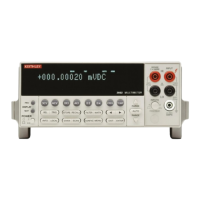Front Panel Operation
2-22
Crest factor —
The crest factor of a waveform is the ratio of
its peak value to its RMS value. Thus, the crest factor speci-
fies the dynamic range of a true RMS instrument. For sinu-
soidal waveforms, the crest factor is 1.414. For a
symmetrical square wave, the crest factor is unity. The crest
factor of a rectangular pulse is related to its duty cycle; as the
duty cycle decreases, the crest factor increases.
For the Model 2002, the additional error term for RMS mea-
surements caused by a high crest factor is specified up to a
value of five. The maximum displayable value is 9.99, else it
shows “over”.
Note that the crest factor is not calculated if dB or dBm is the
presently selected units.
Low level considerations
For sensitive measurements, external considerations besides
the Model 2002 affect the accuracy. Effects not noticeable
when working with higher voltages are significant in micro-
volt signals. The Model 2002 reads only the signal received
at its input; therefore, it is important that this signal be prop-
erly transmitted from the source. The following paragraphs
indicate factors that affect accuracy, including thermal off-
sets and stray pick-up.
Shielding
—
AC voltages that are extremely large compared
with the DC signal to be measured may produce an errone-
ous output. Therefore, to minimize AC interference, the cir-
cuit should be shielded with the shield connected to the
Model 2002 INPUT LO (particularly for low-level sources).
Improper shielding can cause the Model 2002 to behave in
one or more of the following ways:
• Unexpected offset voltages.
• Inconsistent readings between ranges.
• Sudden shifts in reading.
To minimize pick-up, keep the voltage source and the Model
2002 away from strong AC magnetic sources. The voltage in-
duced due to magnetic flux is proportional to the area of the
loop formed by the input leads. Therefore, minimize the loop
area of the input leads and connect each signal at only one
point.
Thermal EMFs
—
Thermal emfs (thermoelectric potentials)
are generated by thermal differences between the junctions
of dissimilar metals. These can be large compared to the sig-
nal that the Model 2002 can measure. Thermal emfs can
cause the following conditions:
• Instability or zero offset is much higher than expected.
• The reading is sensitive to (and responds to)
temperature changes. This effect can be demonstrated
by touching the circuit, by placing a heat source near
the circuit, or by a regular pattern of instability
(corresponding to heating and air conditioning systems,
or changes in sunlight).
To minimize the drift caused by thermal emfs, use copper
leads to connect the circuit to the Model 2002. A banana plug
generates a few microvolts. A clean copper conductor such
as #10 bus wire is ideal for this application. The leads to the
input may be shielded or unshielded, as necessary. Refer to
Shielding.
Widely varying temperatures within the circuit can also cre-
ate thermal emfs. Therefore, maintain constant offset tem-
peratures to minimize these thermal emfs. A cardboard box
around the circuit under test also helps by minimizing air
currents.
The REL control can be used to null out constant offset
voltages.
Note that additional thermals may be generated by the
optional Model 2002-SCAN scanner card.
AC voltage offset
—
The Model 2002, at 5
½
d resolution,
will typically display 150 counts of offset on AC volts with
the input shorted. This offset is caused by the offset of the
TRMS converter. This offset will not affect reading accuracy
and should not be zeroed out using the rel feature. The fol-
lowing equation expresses how this offset (V
OFFSET
) is added
to the signal input (V
IN
):
Example: Range = 2VAC
Offset = 150 counts (1.5mV)
Input = 200mV RMS
The offset is seen as the last digit which is not displayed.
Therefore, the offset is negligible. If the rel feature were used
to zero the display, the 150 counts of offset would be sub-
tracted from V
IN
resulting in an error of 150 counts in the dis-
played reading.
Displayed
reading V
IN
()
2
+V
OFFSET
()
2
=
Display
reading 200mV
()
2
+ 1.5mV
()
2
=
= 0.04V 2.25 10
-6
V×()+
=
.200005V

